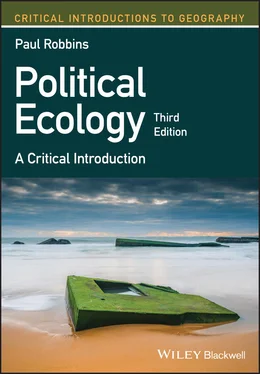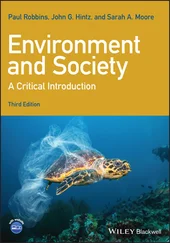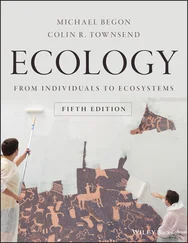The problems with this line of argument are many. In general terms, and as will be shown throughout this book, the demographic explanation is a consistently weak predictor of environmental crisis and change. First, this is because the mitigating factors of affluence and technology tend to overwhelm the force of crude numbers. A very few members of the global village, after all, consume the majority of its resources ( Table 1.2).
Table 1.2 Who is overpopulated? Comparative per capita consumption of resources and production of waste.
(Data adapted from World Resources Institute 2005).
| Resource |
India |
United States |
| Meat (kg, 2009) a |
4 |
120 |
| Water (m 3, 1996–2005) b |
1,089 |
2,842 |
| Energy (kg oil equivalent, 2013) c |
606 |
6,915 |
| Carbon emissions (metric tons, 2013) c |
1.6 |
16.4 |
India is three times larger than the United States, in terms of population, but consumes a comparatively tiny quantity of key resources and produces a fractional amount of waste.
a Food and Agriculture Organization of the United Nations
b Water Footprint Network ( http://waterfootprint.org/en/resources/water‐footprint‐statistics/#CP3)
c World Bank – World Development Indicators
The more fundamental problem with this formulation, however, is that it posits the environment as a finite source of basic unchanging and essential elements, which set absolute limits for human action. However intuitive (divide a limited stock of earth materials by a potentially infinite hungry human population and the result always approaches zero), this assumption has proved historically false and conceptually flawed.
Market “optimists,” expressing the problem in economic terms, suggest that any form of resource scarcity creates a response that averts serious crisis. As a good becomes scarcer, they suggest, its price tends to rise, which results either in the clever use of substitutes and new technologies to increase efficiency, or in a simple decreased demand for that good. The result is that apparently finite resources are stretched to become infinitely available as consumers use less and producers supply more efficient alternatives and substitutes (Rees 1990). Even if populations rise on a limited land area, for example, the demand for land and rising land rents will increase its efficiency of use, with more and better production on each unit of land. Even if petroleum becomes scarce, the rising price per barrel will encourage the use of otherwise expensive alternatives like wind and solar power, or simply cause consumers to drive less, endlessly stretching the world's energy supply. While such optimistic prognoses are themselves fraught with problems, they do point to an important and increasingly well‐accepted truism: resources are constructed rather than given.
Finally, the overall global trajectory of population is actually headed in the reverse direction from that predicted by Malthusian catastrophists. As of 2017, more than half the countries of the world were in a state of population decline, where fertility rates have fallen to less than the replacement rate (approximately 2.1 children per family). The seriousness of this transition is notable insofar as the greatest challenge for many countries in demographic decline is labor scarcity , not a surplus of people (Robbins and Smith 2017).
Since it was first offered up in Malthus' 1793 formulation, the ecoscarcity argument has been presented as an explicit justification for social policy. In particular, Malthus insisted that since famine and starvation were essential to controlling runaway human populations, such events are “natural” and inevitable. England's Poor Laws, the modest redistributive welfare subsidies to feed the most marginal groups, were pointless and counter‐environmental. By increasing rather than decreasing their numbers, such subsidies were the source rather than the solution of misery (Malthus 1992, book 4, ch. 3, p. 227).
The implications for contemporary global environmentalism are equally programmatic. Environmental crises as demographic problems exist at the site of resource use, in and amongst the world's poor, who are simply too numerous. Subsidies of the poor do little to alleviate the crisis, since they only serve to reinforce the demographic trend. Population control, rather than reconfiguration of global distributions of power and goods, is the solution to ecological crisis. The continued advocacy of an apolitical natural‐limits argument, therefore, is implicitly political , since it holds implications for the distribution and control of resources. Even so, Malthusianism regrettably remains a typical way of thinking about environmental change, and so provides a unifying target for many political ecologists.
Other apolitical ecologies: diffusion, valuation, and modernization
Other prominent accounts of environmental change also dominate current thinking, asserting apolitical answers to extremely political questions. It is commonly argued, for example, that ecological problems and crises throughout the world are the result of inadequate adoption and implementation of “modern” economic techniques of management, exploitation, and conservation. Generally, this way of thinking is underpinned by a commitment to economic efficiency.
These approaches to environmental management and ecological change generally assert that efficient solutions, determined in optimal economic terms, can create “win–win” outcomes where economic growth (sometimes termed “development”) can occur alongside environmental conservation, simply by getting the prices and techniques right. Such approaches are persuasive, at least insofar as they reject the cataclysmic prognoses of Malthusian catastrophe described above. By freeing individuals and firms to seek their own best and most efficient use of resources, propelled by competition on an open market and sustained by modern technology, waste, environmental destruction, and resource degradation might be tamed.
For global ecology, such an approach suggests several general principles and policies. (1) Western/northern technology and techniques need to be diffused outwards to the underdeveloped world. (2) Firms and individuals must be connected to larger markets and given more exclusive property controls over environmental resources (e.g., land, air, wildlife). (3) For wilderness and biodiversity conservation, the benefits of these efficiencies must be realized through institutionalizing some form of valuation; environmental goods like wildebeest, air, and stream quality might be properly priced in an open market.
The debates and critiques surrounding such approaches and the logics that underpin them are too numerous to summarize here; even so, there are some serious general conceptual and empirical problems with this perspective. First, the assertion that modern technologies and markets can optimize production in the underdeveloped world, leading to conservation and environmental benefits, has proven historically uneven. The experience of the green revolution, where technologies of production developed in America and Europe were distributed and subsidized for agrarian production around the world, led to what even its advocates admit to be extensive environmental problems: exhausted soils, contaminated water, and increased pest invasions (Lal et al. 2002). Beyond these failings, the more general assertion that superior environmental knowledge originates in the global north for transfer to the global south is in itself problematic, reproducing as it does paternalistic colonial knowledge relations and a priori discounting the environmental practices of indigenous and local communities (Uphoff 1988). Efforts to price the economic value of environmental systems – most commonly referred to as “ecosystem services” in this approach – can result in remarkable unjust outcomes (Sikor 2013). A call to intensify these forms of exchange must be viewed skeptically.
Читать дальше












